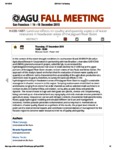Use este identificador para citar ou linkar para este item:
http://www.alice.cnptia.embrapa.br/alice/handle/doc/1037613| Título: | Land use effects on quality and quantity aspects of water resources in headwater areas of the Jaguari River Basin. |
| Autoria: | CAMARGO, P. B. de  FIGUEIREDO, R. de O.   PICCOLO, M. C.   ZUCCARI, M. L.   FERRACINI, V. L.   CRUZ, P. P. N.   GREEN, T. R.   COSTA, C. F. G.   REIS, L. C.   |
| Afiliação: | P. B. de CAMARGO, USP; RICARDO DE OLIVEIRA FIGUEIREDO, CNPMA; M. C. PICCOLO, USP; MARIA LUCIA ZUCCARI, CNPMA; VERA LUCIA FERRACINI, CNPMA; P. P. N. CRUZ; T. R. GREEN, USDA ARS; C. F. G. COSTA, CENA/ESALQ/USP; L. C. REIS, USP. |
| Ano de publicação: | 2015 |
| Referência: | In: 2015 AGU FALL MEETING, 2015, San Francisco. E-posters... San Francisco: 2015. Ref. H43B-1487. |
| Conteúdo: | In the context of the recent drought conditions in southeastern Brazil, EMBRAPA (Brazilian Agricultural Research Corporation) in partnership with two Brazilian universities (USP/CENA and UNIFAL) planned a research project, called BaCaJa, to understand the hydrobiogeochemistry processes that occur in small catchments (<1,000 ha) at the upper portions of the Jaguari River Basin situated on both states of Sao Paulo and Minas Gerais. The approach of this study is based on the fact that the evaluation of stream water quality and quantity is an efficient tool to characterize the sustainability of the agriculture production at a catchment level. Its goal is, therefore, to survey the land use effects on the hydrobiogeochemistry in headwaters areas of the Jaguari River Basin to support sustainable management of water resources in this region. Sampling stations were established on rivers and streams ranging from one to five order channels as well as selected small catchments to conduct studies on overland flow, soil solution, soil quality, aquatic biota and pesticide dynamic. The research team is huge and their goals are specific, diverse and complementary, being summed up as: characterize land use, topography and soils; evaluate erosive potential in agriculture areas; measure soil carbon and nitrogen contents; characterize hydrogeochemistry fluxes; apply hydrological modeling and simulate different land use and management scenarios; monitor possible pesticides contamination; and survey macro invertebrates as indicators of water quality. Based on a synthesis of the results, the project team intends to point out the environmental impacts and contribute recommendations of management for the focused region to conserve water resources in terms of quality and quantity. |
| Thesagro: | Água |
| NAL Thesaurus: | Land use |
| Tipo do material: | Resumo em anais e proceedings |
| Acesso: | openAccess |
| Aparece nas coleções: | Resumo em anais de congresso (CNPMA)  |
Arquivos associados a este item:
| Arquivo | Descrição | Tamanho | Formato | |
|---|---|---|---|---|
| 2015RA026.pdf | 220,1 kB | Adobe PDF |  Visualizar/Abrir |









